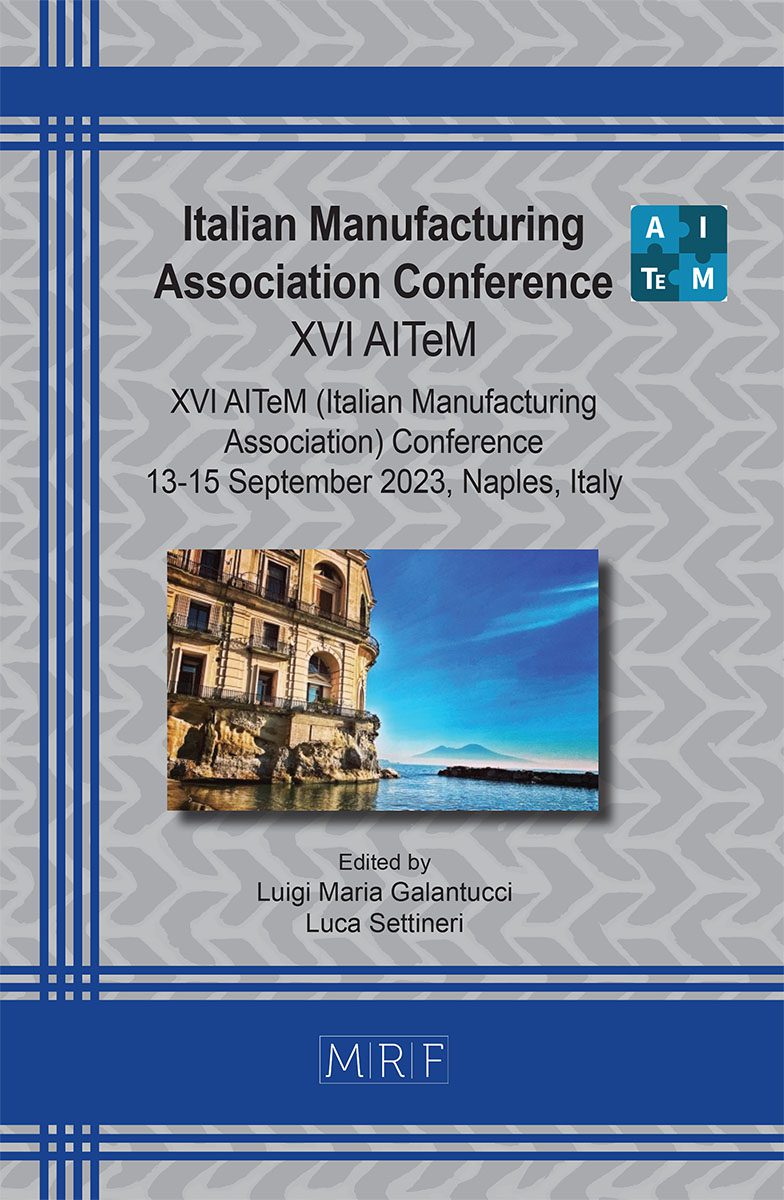Comparison of specific cutting energy in dry and wet post- process turning of Ti6Al4V EBM parts
Ersilia Cozzolino, Stefania Franchitti, Rosario Borrelli, Antonello Astarita
download PDFAbstract. Additive Manufacturing (AM) is accelerating more and more today. Among its advantages, AM is claimed to be green technology. However, AM parts usually require postprocessing to improve their surface finishing and to be assembled. In this study, some Ti6Al4V cylindrical samples have been manufactured by Electron Beam Melting and then post- processed by turning. Both dry and wet turning has been performed under the same process parameters. Surface roughness has been measured both before and after each turning pass along the parallel and perpendicular direction to the cylindrical axis and energy consumption has been recorded during each turning pass. Specific Cutting Energy (SCE) has been calculated to evaluate the energy efficiency of the turning process. The results of this study demonstrate that dry turning is more energy efficient than wet turning by selecting the same machining process parameters while obtaining a comparable surface roughness.
Keywords
Sustainable Manufacturing, Electron Beam Melting, Machining
Published online 9/5/2023, 8 pages
Copyright © 2023 by the author(s)
Published under license by Materials Research Forum LLC., Millersville PA, USA
Citation: Ersilia Cozzolino, Stefania Franchitti, Rosario Borrelli, Antonello Astarita, Comparison of specific cutting energy in dry and wet post- process turning of Ti6Al4V EBM parts, Materials Research Proceedings, Vol. 35, pp 95-102, 2023
DOI: https://doi.org/10.21741/9781644902714-12
The article was published as article 12 of the book Italian Manufacturing Association Conference
![]() Content from this work may be used under the terms of the Creative Commons Attribution 3.0 license. Any further distribution of this work must maintain attribution to the author(s) and the title of the work, journal citation and DOI.
Content from this work may be used under the terms of the Creative Commons Attribution 3.0 license. Any further distribution of this work must maintain attribution to the author(s) and the title of the work, journal citation and DOI.
References
[1] A. Sartal, R. Bellas, A.M. Mejías, A. García-Collado, The sustainable manufacturing concept, evolution and opportunities within Industry 40: A literature review, Adv. Mech. Eng. 12 (2020). https://doi.org/10.1177/1687814020925232
[2] S. Liu, Y.C. Shin, Additive manufacturing of Ti6Al4V alloy: A review, Mater. Des. 164 (2019) 107552. https://doi.org/10.1016/j.matdes.2018.107552
[3] R. Vaßen, J. Fiebig, T. Kalfhaus, J. Gibmeier, A. Kostka, S. Schrüfer, Correlation of Microstructure and Properties of Cold Gas Sprayed INCONEL 718 Coatings, J. Therm. Spray Technol. 29 (2020) 1455-1465. https://doi.org/10.1007/s11666-020-00988-w
[4] M. Koike, K. Martinez, L. Guo, G. Chahine, R. Kovacevic, T. Okabe, Evaluation of titanium alloy fabricated using electron beam melting system for dental applications, J. Mater. Process. Technol. 211 (2011) 1400-1408. https://doi.org/10.1016/j.jmatprotec.2011.03.013
[5] V. Upadhyay, P.K. Jain, N.K. Mehta, In-process prediction of surface roughness in turning of Ti-6Al-4V alloy using cutting parameters and vibration signals, Meas. J. Int. Meas. Confed. 46 (2013) 154-160. https://doi.org/10.1016/j.measurement.2012.06.002
[6] F. Hojati, A. Daneshi, B. Soltani, B. Azarhoushang, D. Biermann, Study on machinability of additively manufactured and conventional titanium alloys in micro-milling process, Precis. Eng. 62 (2020) 1-9. https://doi.org/10.1016/j.precisioneng.2019.11.002
[7] E. Cozzolino, A. Astarita, R. Borrelli, S. Franchitti, V. Lopresto, C. Pirozzi, A Preliminary Investigation of Energy Consumption for Turning Ti6Al4V EBM Cylindrical Parts, 926 (2022) 2355-2362. https://doi.org/10.4028/p-vm4f1y
[8] E. Cozzolino, S. Franchitti, R. Borrelli, C. Pirozzi, A. Astarita, Energy consumption assessment in manufacturing Ti6Al4V electron beam melted parts post processed by machining, Int. J. Adv. Manuf. Technol. (2023) 1289-1303. https://doi.org/10.1007/s00170-022-10794-z












